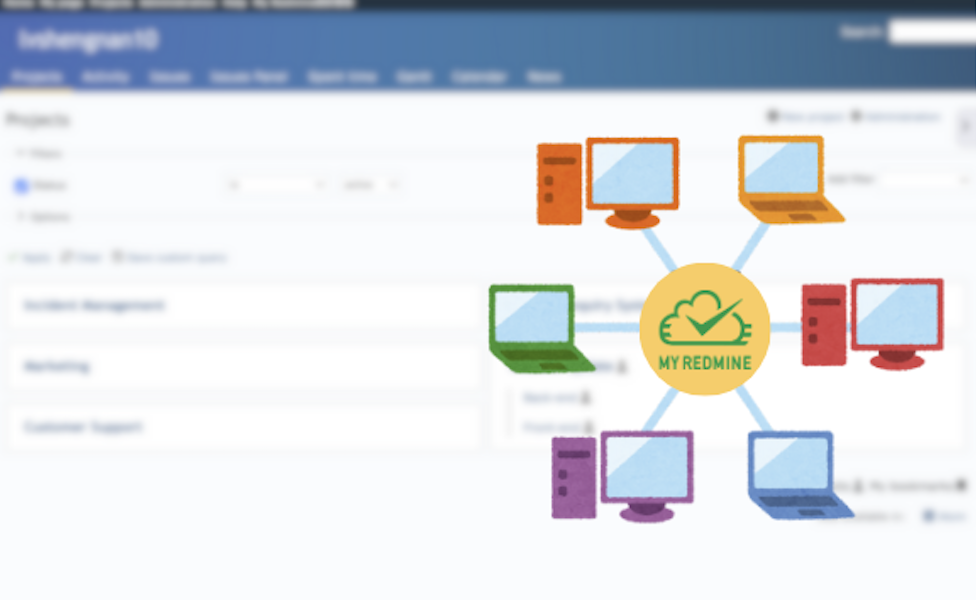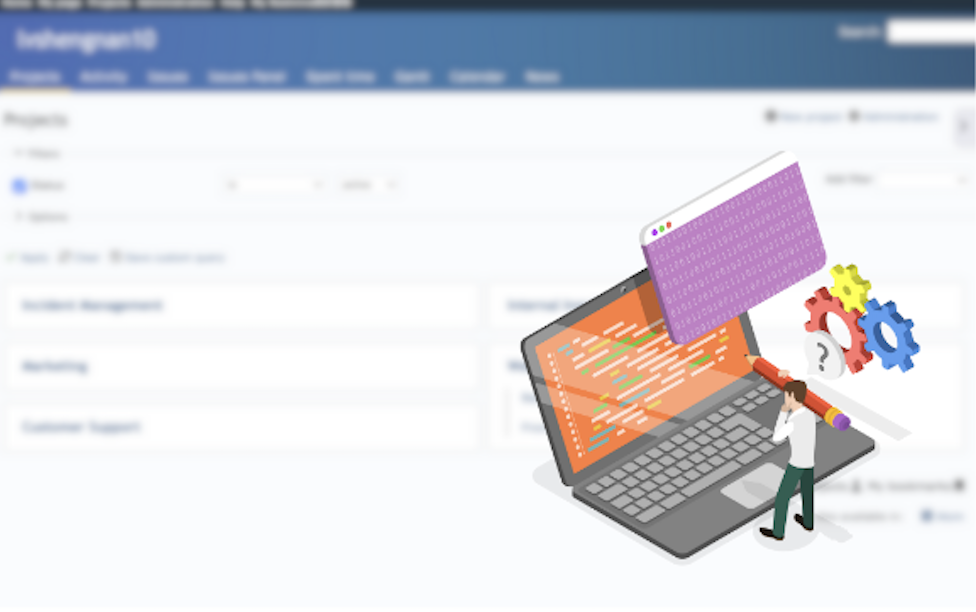My Redmine for Incident Management
My Redmine for Incident Management
Redmine provides a robust foundation for incident management, making it an indispensable tool for managing incidents effectively.
Incident Tracking and Transparency
My Redmine facilitates clear tracking of incidents, allowing clients to log issues as they occur and providing both parties with transparent, real-time updates.
Controlled Testing Environment
Through IP address restrictions, My Redmine enables secure, client-specific access during testing phases, supporting focused and safe issue resolution.

Maintenance-Free Infrastructure
With My Redmine, companies shift from managing infrastructure to focusing on incident resolution, improving response times and overall security management.

Effective Incident Management with My Redmine
If you’re familiar with Redmine, you’ll know it’s particularly well-suited for IT engineers. Redmine offers a strong foundation for incident management, making it an invaluable tool for IT professionals managing incidents.
We spoke with some of our users—leading IT solution providers in Japan—to learn how they leverage My Redmine to streamline their incident management processes. In this article, we’ll share insights into how My Redmine boosts workflow efficiency, simplifies client collaboration, and removes the burden of maintenance.
| Consistent Approaches to Incident Management
Most of our users adopt similar practices when using My Redmine for incident management. Rather than handling all project tasks in My Redmine, they focus on engaging clients through system reviews. During these reviews, clients are encouraged to create new issues in My Redmine to report any operational problems or specification mismatches they discover. This approach enables clients to log issues in real-time, which the company can then address, provide feedback on, and mark as resolved.
Using My Redmine for information sharing also helps both teams quickly determine whether each issue arises from client requests or specification gaps, allowing for clearer prioritization and faster resolutions.
| Supporting Client Collaboration at Their Own Pace
Another key benefit of My Redmine is its flexibility, allowing clients to interact with the system at their own convenience. When regular meetings or frequent interactions are difficult to arrange, clients can access My Redmine to log incidents or give feedback on their own schedule. This workflow keeps the process efficient, enabling teams to respond as needed without the need for constant, real-time communication. Many of our users find that this approach not only enhances efficiency but also respects client schedules and internal processes.
| Seamless Migration and Reduced Maintenance
One of our users, a company specializing in Ruby-based contract development, had relied on an on-premise Redmine setup for many years. Although they have many highly skilled engineers who are well-versed in OSS and fully capable of handling on-premise Redmine, they ultimately chose to migrate their data to our service and began using My Redmine.
After the transition, they experienced significant benefits. The migration eliminated the ongoing maintenance burden and resolved all security concerns associated with managing their own server infrastructure. By moving to My Redmine, they gained peace of mind, knowing that system upkeep and security are continuously managed for them.
| IP Address Restrictions for Controlled Access
Another user highlighted My Redmine’s unique IP address restriction feature. When beginning tests for a new system, they add the client’s IP address to the “Allowed IP Addresses” list, granting temporary access for the client to create issues and interact directly with the incident management team. Once testing is complete, the IP address is removed, ensuring controlled access and maintaining data security.

Client-Centered Incident Reporting
There is also another type of My Redmine user—a company that provides testing services for their clients, following a pattern that is the reverse of the cases mentioned above. Here’s how they use My Redmine to manage interactions with their customers:

For example, when testing a new product, such as a camera, if an issue like failure to start occurs, they create a separate issue for each problem to report it to the client. They provide the client with steps to reproduce the issue, and if it is confirmed as a problem, they proceed with program modifications. The overall test results are managed separately in a spreadsheet, and ultimately, they deliver the final list as a file. Additionally, all file exchanges and work reports are handled and centrally managed within My Redmine.
Ingenuity in the Use of My Redmine
Our customers have also shared tips on how to use My Redmine efficiently for incident management.
| Organizing Incident Data with Custom Fields
Instead of inputting all information into the description field, create custom fields to organize data systematically. For instance, when testing smartphones, you can use custom fields to specify the model and OS version. This approach allows you to sort and filter issues directly on the issue list screen, making it easier to analyze issues in final reports. For example, you can identify which models had the most problems or determine the most common types of issues.

| Establishing Clear Rules for Issue Updates
For clients using Redmine for the first time, it’s helpful to provide clear guidelines on issue updating rules. You could add simple instructions at the end of the issue description, such as how and when to update the status or change the assignee. For example, when creating an issue with a question, assign the intended recipient as the assignee. While the recipient can add comments to answer the question, they may not always update the assignee, status, or progress rate, making it difficult to track updates at a glance from the issue list. Implementing a clear rule, such as requiring the assignee to update the status and progress rate after answering, can solve this problem.

Since it’s often unclear who is familiar with these rules when team members change, consider attaching these guidelines as a template to ensure consistency. Alternatively, you can summarize the rules in a document or include them in the project overview for easier reference.
Enhancing Efficiency and Client Satisfaction with My Redmine
These examples make it clear that My Redmine is a valuable platform for efficient incident management. By facilitating secure, flexible client interactions and removing the need for on-premise maintenance, My Redmine supports seamless workflows and better aligns with IT engineers’ needs in today’s digital landscape. We hope these insights encourage other teams to explore how My Redmine could enhance their own incident management and client collaboration processes.